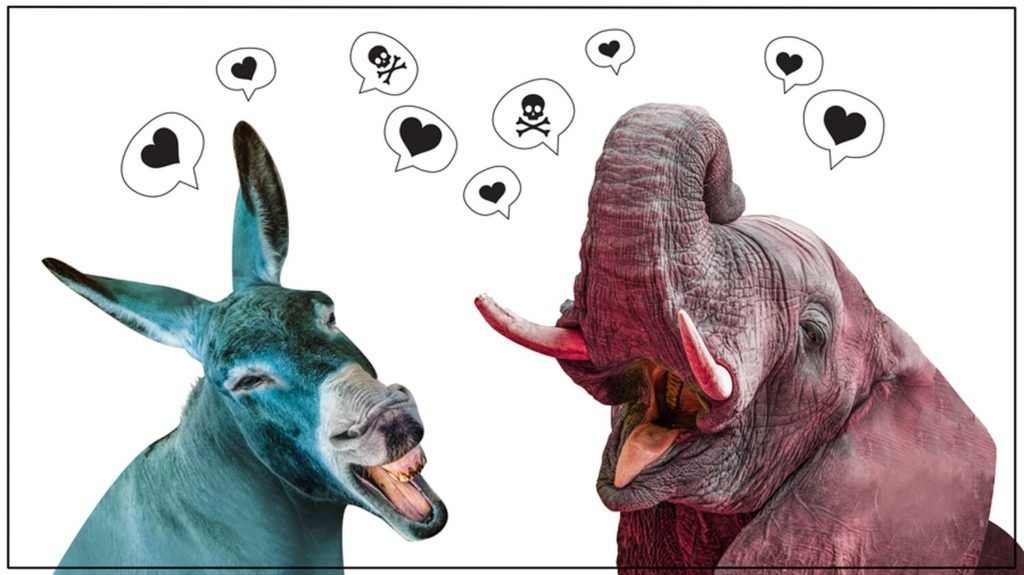[h/t Santa Fe Reporter]
In a downstairs classroom of the Santa Fe Community Foundation, 10 people with often differing and sometimes opposite political beliefs sit around a long wooden table, chatting and joking as a short break in the action wraps up. They’re nearing the end of a workshop by Braver Angels, an organization that brings “reds” and “blues” into dialogue in hopes of depolarizing American politics.
It’s Saturday, Jan. 18—two days since the US House of Representatives presented the Senate with two articles of impeachment against President Donald Trump. Closer to home, the same date is three days before the 30-day New Mexico legislative session begins. In less than two weeks, Iowans will cast the first votes in the Democratic presidential primary.
The mood in the room feels surprisingly cordial.
Paul Gibson and Roxanne Barber, a couple that headed the Santa Fe for Bernie campaign in 2016, trade glances as the moderators call for quiet.
Gibson takes his seat next to Rip Ryness, head of the Santa Fe County Republicans. Ryness is amicably debating something with Eric Jeffries, a Democrat who describes himself as “closer to the center.” Across the table, Mark Abramson and Elaine Sullivan are laughing; they lean together for a brief shoulder squeeze.
Sullivan is a leading advocate for public banking in New Mexico. Abramson is an Albuquerque attorney and owner of the Los Ranchos Gun Shop. The two are unlikely to ever agree on a long list of issues. But over the course of the day, they’ve uncovered some areas of common ground.
According to Scott Lopez, founder of the New Mexico chapter of Braver Angels, this is precisely the point.
“We are not here to try to change anybody’s mind,” says Lopez. “The idea is to come together to learn to respect each other’s dignity and humanity.”
Braver Angels uses family therapy and marriage counseling techniques to bring people together across the political divide.
Saturday’s event starts with introductions and a discussion of common stereotypes of both the “reds” and the “blues.”
Next, the flip of a coin determines that reds would go first in an activity called the “fishbowl.”
They take their seats in a small circle in the center of the room. The blues are asked to make a second circle around the reds, to remain silent and listen.
“Why do you think your side’s values or policies are good for the country?” a moderator asks the inner circle.
Reds, they say, promote policies that keep government spending in check by limiting cumbersome social programs, which can be inefficient because all individuals have unique needs.
Their priorities promote a republic, they say, in which each state functions as its own experiment in democracy. They also say reds value free enterprise, which encourages individual motivation and entrepreneurship leading to more opportunities for everyone.
The moderator takes a moment to let the conversation settle, then asks: “What reservations do you have about your side?” And with this question, the united red front fractures into five individuals who each have different and sometimes controversial concerns.
One man voices discomfort with the red side’s rejection of science and refusal to regulate guns. Others worry reds are failing their constituents because of their “allegiance to corporations.”
Kelly Ward, whose background includes serving as former Gov. Gary Johnson’s first campaign manager and later as Johnson’s chief of staff, argues that reds were forgetting to champion things that matter to everyday people in New Mexico, such as education. “The American Dream is not working for a lot of people, and conservatives are not willing to recognize that,” he says with a sigh. “We’ve created a structure that is OK with leaving people out.”
When the blues enter the center circle, they agree that some people have more opportunities than others. Women, for instance, are still paid less than men, and people of color are incarcerated at higher rates than whites for the same crimes.
Blues try to create policies that correct these power imbalances that stem from a history of oppression, such as segregation and barring women from the ballot box, they say. Blues, they add, are more likely to look for allies in foreign policy. They say their views are based in fact, rather than in ideology.
As they voice their concerns, one person worries that moderate Democrats were being silenced and ostracized, while another worries that the center is too quick to label progressive ideas as “extremist.”
Some blues think their side was too tied to corporate interests, too. Others acknowledge that government spending is out of control.
“Sometimes we just throw money at problems because we so desperately want things to change,” Sullivan says.
Afterwards, the group discusses what each person learned from the other side, what surprised them, and where they could begin to see some common ground.
“I thought all the blues would see things the same way, and it’s refreshing to see that we actually all have disagreements within our own groups,” says Page Ollice, a red who leans “more Libertarian.”
Issues where at least one member from each side find common ground include concerns about education, distrust of media, disdain for Donald Trump’s behavior and fear of corruption. They see competition as critical to American success, worried the wealthiest Americans don’t pay enough in taxes and say military spending and social programs should be limited. They discussed how to to build an innovative and bi-partisan alternative energy economy in New Mexico.
As the group shares their takeaways at the end of the day, not everyone is optimistic—some still feel diametrically opposed. But most say they have learned to value other opinions more and are learning to listen with less judgement.
“I came here feeling like Democrats and Republicans were so opposed that there’s no hope,” says Laura Riedel, a member of the blue side. “Now I’m leaving with a sense of hope.”
For full article go to:
https://www.sfreporter.com/news/2020/01/22/depolarizing-american-politics/




